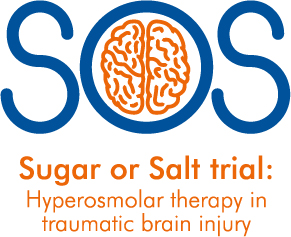Frequently asked questions
If a patient has already received hyperosmolar therapy before admission to ICU are they still eligible for the SOS trial?
Patients that have been given hyperosmolar therapy prior to ICU admission are still eligible for SOS. The rationale is that this trial is addressing the use of hyperosmolar therapy in monitored patients in intensive care. Un-monitored hyperosmolar therapy occurs in practice currently and is likely to continue after this trial. The sub-set of patients (with clinical signs of raised ICP) frequently will go direct to theatre for surgical intervention, which may resolve the raised ICP or indicate that injuries are non-survivable.
What if the patient’s ICP reduces to <20mmHg between randomising them and starting hyperosmolar therapy?
If after randomisation the ICP has reduced to less than 20mmHg and hyperosmolar therapy is no longer required, you should not administer the treatment allocated at randomisation. The patient will be retained in the analysis on an intention-to-treat basis, and data collection and follow-up should be completed as per protocol.
What if there is a transient increase in the patient’s ICP >20mmHg?
In the event of a transient increase in ICP for example following suction or rolling the patient, clinicians should apply their judgement as to the need for hyperosmolar therapy. If hyperosmolar therapy is deemed necessary, treatment should be started/continued using the allocated trial treatment.
Which should be prioritised: maintaining MAP at >80mmHg or CPP between 60-70mmHg?
Sites should use their local protocols to decide CPP and MAP targets. Management of stage 1 and 3 therapies should be done in accordance with local protocols – Figure 3 of the SOS protocol only gives an indication of what these stage 1 and stage 3 procedures might include.
Why are we not measuring serum osmolality?
We are not measuring serum osmolality due to the difficulties in measuring it at the bedside for patients given Mannitol. Although blood gas analysers in ICU will give a ‘calculated’ value for osmolality, Mannitol is osmotically active and the machine does not measure it as an individual constituent, making the results inaccurate. In order to get an accurate osmolality measurement, it would need to be done in a biochemistry lab. However due to the time delay in getting the results from the lab, this would not be feasible for the study.
Are blood gas readings acceptable for measuring serum sodium levels?
Yes, ABG measurements can be used for serum sodium levels assuming the readings are accurate. You should follow local protocols for measuring serum sodium and do not need to request additional readings from the lab for the daily data collection.
Is there a specific timeframe between confirming eligibility and randomising the patient?
There is no set timeframe in the protocol as we recognise there will be variation in the clinical pathway. However, eligibility should be confirmed as close as possible to the time of randomising the patient and osmotherapy should still be clinically indicated at the time of randomisation.
The time of the most recent eligibility assessment prior to randomisation should be recorded on the screening and eligibility CRF.
If the patient has already been given a dose of hyperosmolar therapy since admission to ICU, are they still eligible for the trial?
Patients that meet the eligibility criteria should be randomised at the earliest opportunity. However, if the patient has received a single dose of hyperosmolar therapy on the ICU before eligibility is confirmed e.g. prior to going to theatre, this would not preclude them from being enrolled.
Do we have to follow all of the stage 1 measures that are listed in the trial flowchart in the protocol before the patient can be enrolled?
The Stage 1 measures in the Study protocol have been provided for reference. However, you should follow your local protocols for stage 1 measures. The measures listed in the trial flowchart are examples of what this may involve.
If the patient is discharged to a rehab unit, would this be classed as being discharged from hospital?
Yes. The trial hospital discharge data should be collected before the patient is discharged to a rehab unit. If the patient is transferred to another hospital before being discharged to a rehab unit, you should follow up with the final hospital as much as is practically possible to collect the final hospital discharge data prior to discharge.
Why was a serum sodium limit of 155mmol/L selected?
There is variation between sites on the serum sodium limit used to stop administering hyperosmolar therapy, ranging from 155 – 160mmol/L. This was considered by the trial management group with a focus on safety and the consensus was that a limit of 155mmol/L should be used for the SOS trial. The impact of this threshold will be monitored through the screening data provided by sites.
If the patient is discharged before the end of the 28 day SAE reporting window, do we need to follow up with the patient to determine if any SAEs have occurred post-discharge?
You are not expected to actively follow up with the patient once they have been discharged from hospital to determine if any SAEs have occurred. However, should you become aware of any SAEs that have occurred e.g. if the patient is re-admitted, then these must still be reported to WCTU.
Enquiries:
If you have any questions about the SOS trial, please contact the trial team who will be happy to answer them.
Trial Manager: Dr Hannah Noordali
Tel: 024 761 50478
Trial Coordinator: Nadia Wustrack-Law
Tel: 024 761 51738
Email: SOStrial@warwick.ac.uk
Address:
SOS Trial
Warwick Clinical Trials Unit
Warwick Medical School
University of Warwick
Coventry
CV4 7AL

